Inisheer
Inis Oírr or Inisheer is the smallest and most eastern of the three Aran Islands in Galway Bay, Ireland. With about 260 permanent residents (2016 census), it is more populous than Inishmaan but less than Inishmore. Caomhán of Inis Oírr is the island's patron saint. There are five primary settlements on Inis Oírr, including Baile Thiar, Baile an tSéipéil (Chapeltown), Baile an Chaisleáin (Castle Village), Baile an Fhormna and Baile an Lorgain (Town of the shin-shaped hill).
| Native name: Inis Oírr | |
|---|---|
.jpg.webp) | |
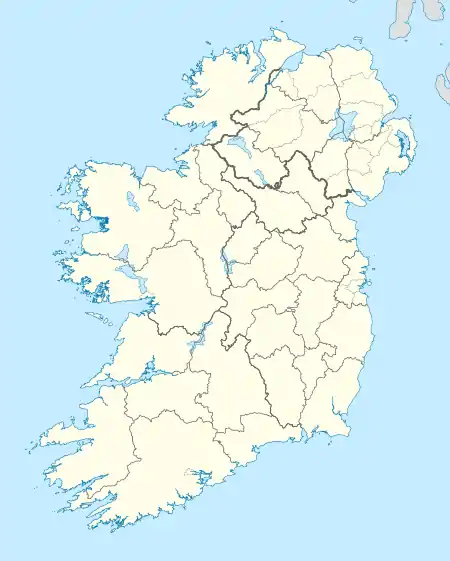 Inisheer / Inis Oírr | |
| Geography | |
| Location | Atlantic Ocean |
| Coordinates | 53°03′29″N 9°31′39″W |
| Area | 8 km2 (3.1 sq mi) |
| Administration | |
| Province | Connacht |
| County | Galway |
| Demographics | |
| Population | 260 (2016) |
| Ethnic groups | Irish |
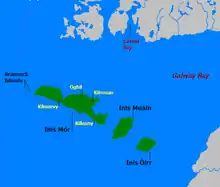
Naming
The official name, Inis Oírr, was brought into usage by the Ordnance Survey Ireland. It may be a compromise between the traditional local name Inis Thiar and the previous official name Inis Oirthir.[1] There is no Irish word corresponding to the second element in the official name. It seems from the annals that the island's name always contained the element iarthar or thiar in the sense of "rear" or "back" island and not "west" as is the usual sense of this word. The form Inis Oirthir, used by the 17th century scholar Ruaidhrí Ó Flaithbheartaigh, seems to have arisen out of his own misreading of the annals.[2][3]
Geology and geography
The island is geologically an extension of The Burren. The terrain of the island is composed of limestone pavements with crisscrossing cracks known as "grikes", leaving isolated rocks called "clints".
The limestones date from the Viséan period (Lower Carboniferous), formed as sediments in a tropical sea approximately 350 million years ago, and compressed into horizontal strata with fossil corals, crinoids, sea urchins and ammonites.
Glaciation following the Namurian phase facilitated greater denudation. The result is that Inisheer is one of the finest examples of a Glacio-Karst landscape in the world. The effects of the last glacial period (the Midlandian) are most in evidence, with the island overrun by ice during this glaciation. The impact of earlier Karstification (solutional erosion) has been eliminated by the last glacial period, so any Karstification now seen dates from approximately 10,000 years ago and the island Karst is thus recent.
Solutional processes have widened and deepened the grykes of the limestone pavement. Pre-existing lines of weakness in the rock (vertical joints) contribute to the formation of extensive fissures separated by clints (flat pavement like slabs). The rock karstification facilitates the formation of sub-terrainean drainage.
Climate and agriculture
The island has a temperate climate. Average air temperatures range from 15 °C (59 °F) in July to 6 °C (43 °F) in January. The soil temperature does not usually drop below 6 °C (43 °F). Since grass will grow once the temperature rises above 6 °C (43 °F), this means that the island (like the neighbouring Burren) has one of the longest growing seasons in Ireland, and supports diverse and rich plant growth.
Late May is the sunniest time,[4] and also likely the best time to view flowers, with the gentians and avens peaking (but orchid species blooming later).
Flora and fauna
The island supports arctic, Mediterranean and alpine plants side-by-side, due to the unusual environment. Like the Burren, the Aran islands are known for their remarkable assemblage of plants and animals.[5] The grikes (crevices) provide moist shelter, thus supporting a wide range of plants including dwarf shrubs. Where the surface of the pavement is shattered into gravel, many of the hardier Arctic or Alpine plants can be found. But when the limestone pavement is covered by a thin layer of soil, patches of grass are seen, interspersed with plants like the gentian and orchids.
Notable insects present include the butterfly the pearl-bordered fritillary (Boloria euphrosyne), brown hairstreak (Thecla betulae), marsh fritillary (Euphydryas aurinia) and wood white (Leptidea sinapis); the moths, the burren green (Calamia tridens), Irish annulet (Gnophos dumetata) and transparent burnet (Zygaena purpuralis); and the hoverfly Doros profuges.
History
In 1885 a burial site called Cnoc Raithní was discovered which dates back to 1500 BC. This is earliest evidence of human settlement of the island.[6]
Saint Caomhán, the patron saint of Inisheer, according to some traditions, was the elder brother of Kevin of Glendalough. The ruins of Teampall Chaomháin have to be uncovered annually as the floor of it is well below the level of the sand. In the Middle Ages, the island was ruled by the O'Brien dynasty who provided most of the Kings of Thomond. This rule was exercised since before the Anglo-Irish settled in Connacht in the 1230s.
The Tribes of Galway paid the O'Briens an annual tribute of twelve tuns of wine "in consideration of their protection and expenses in guarding the bay and harbour of Galway against pirates and coast plunderers." The remains of the 14th-century 'O'Brien's Castle' is sited near the island's highest point. In 1582 the O'Flahertys of Connemara captured it. Today O'Flahertys still live on the island. In 1652 it was given to the Cromwellian invasion force and the O'Flaherty's were defeated. They saw no use for it and the castle was partially dismantled, it has been unoccupied since.[7][8]
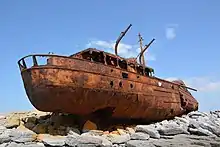
The cargo vessel Plassey was shipwrecked off Inis Oírr on 8 March 1960, and has since been thrown above high tide mark at Carraig na Finise on the island by strong Atlantic waves. The ship features in the opening credits of the TV Show Father Ted.
A group of local Islanders, the Inisheer Rocket Crew,[9] rescued the entire crew from the stricken vessel using a breeches buoy; an event captured in a pictorial display at the National Maritime Museum in Dún Laoghaire.
.jpg.webp)
Antiquities
The following sites on the island are designated as National Monuments:
- Creggankeel Fort (NM 41.01)
- Grave of the Seven Daughters (NM 41.02)
- St. Gobnet's Church (NM 41.05)
- Cnoc Raithní (NM 41.06)
- O'Brien's Castle (NM 41.07)
- St. Cavan's Church (NM 41.08)
Demographics
The table below reports data on Inis Oírr's population taken from Discover the Islands of Ireland (Alex Ritsema, Collins Press, 1999) and the Census of Ireland. Census data in Ireland before 1841 are not considered complete and/or reliable.
|
|
| ||||||||||||||||||||||||||||||||||||||||||||||||||||||||||||||||||||||||||||||||||||
| Source: Central Statistics Office. "CNA17: Population by Off Shore Island, Sex and Year". CSO.ie. Retrieved 12 October 2016. | ||||||||||||||||||||||||||||||||||||||||||||||||||||||||||||||||||||||||||||||||||||||
Transport
The island is reached by ferry from Rossaveal in Connemara and Doolin in County Clare as well as from the other Aran Islands. There is also a regional airport on each island which is served from Connemara Regional Airport by AerArann. A pier was opened in Doolin in June 2015 for commercial ferries serving the island.[10] Islanders travel by foot or car around the island. Tourists can avail of tours/taxi trips by horse and trap. Members of An Garda Síochána patrol on bike.
Language
Irish is still today the daily language of the 260 permanent residents. In addition, many school pupils from the mainland come to the island to learn Irish in an environment where it is a living language in the local college, Coláiste Laichtín during the months of June, July and August.
Sport
Some of the limestone sea cliffs have attracted interest from rock-climbers,[11] though the bigger islands of Inis Mór and Inis Méain are more popular. Diving is possible.[12]
In the media
The island gained some television exposure in the 1990s when it (and 'An Plassy') appeared in the opening credits of the sitcom Father Ted masquerading as the fictional Craggy Island.
Inis Oírr is mentioned in the song "The Return of Pan" by the band The Waterboys.
Inisheer is also the name of a well known slow air written by Thomas Walsh from Dublin, after a visit to the island in the 1970s.[13][14][15]
Inis Oírr was discussed at length in the work of cultural anthropologist John Cowan Messenger under the name Inis Beag.[16][17]
Gallery

 The lighthouse
The lighthouse Eastern coastline
Eastern coastline
 Saint Caomhan's church with Caomhan's grave (Leaba Caomhan) in the background.
Saint Caomhan's church with Caomhan's grave (Leaba Caomhan) in the background. Saint Gobnait's church
Saint Gobnait's church Saint Fiachra's holy well near Cill Gobnait.
Saint Fiachra's holy well near Cill Gobnait.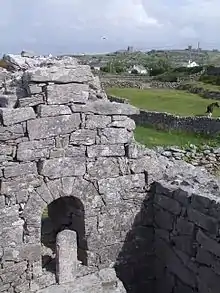 Saint Gobnait's church with the O'Brien fort just visible in the background
Saint Gobnait's church with the O'Brien fort just visible in the background O'Brien fort near the summit of Inisheer. Northern and western elevations
O'Brien fort near the summit of Inisheer. Northern and western elevations O'Brien fort viewed from the lower terraces.
O'Brien fort viewed from the lower terraces. View walking from pier towards beach / O'Brien's Castle
View walking from pier towards beach / O'Brien's Castle Áras Éanna, arts and cultural center
Áras Éanna, arts and cultural center Tobar Éinne (Tobar Éanna), Saint Enda's holy well on Inis Oirr
Tobar Éinne (Tobar Éanna), Saint Enda's holy well on Inis Oirr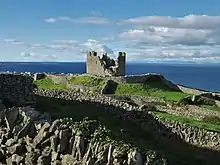 O'Brien's Castle, built in the 14th century
O'Brien's Castle, built in the 14th century
References
- Ó Murchú (Séamas): An tainm áite Inis Oírr in Éigse 26 (1992), pp. 119–123.
- "The Islands of Ireland: Pleasure no matter what you call it". Irish Examiner. 24 July 2017. Retrieved 8 June 2020.
- http://www.folkworld.de/33/e/inisheer.html
- Éireann, Met. "Met Éireann - The Irish Weather Service". www.met.ie.
- Webb, D. A. (1961–1963). "Noteworthy Plants of the Burren: A Catalogue Raisonné". Proceedings of the Royal Irish Academy, Section B. Royal Irish Academy. 62: 117–34. ISSN 0035-8983. JSTOR 20494847.
- http://www.aranislands.ie/cnoc-raithni/
- https://doolinferry.com/aran-island-ferries/inis-oirr/obriens-castle/
- http://aranislands.galway-ireland.ie/obriens-castle.htm
- "Scotch on the rocks - Independent.ie".
- "New Doolin Pier. Official blessing and opening ceremony. - Visit Doolin". 21 June 2015.
- "Aran Islands - Irish Climbing Online Wiki". wiki.climbing.ie.
- "Archived copy". Archived from the original on 17 May 2013. Retrieved 8 October 2013.CS1 maint: archived copy as title (link)
- Thoman Walsh, irishtunecomposers.weebly.com, retrieved 14 Aug. 2017
- The tune Inisheer, thesession.org, retrieved 14. Aug. 2017
- Inisheer, oh Inisheer; The Story of an Irish Air, www.folkworld.de, retrieved 14. Aug. 2017
- Rural Community Studies in Europe. Pergamon Press. 1981. p. 88. ISBN 9781483146256.
Inis Beag – a fictional name for Inisheer
- Ó Giolláin, Diarmuid (2000). Locating Irish Folklore: Tradition, Modernity, Identity. Cork University Press. pp. 183.
inis beag inisheer -wikipedia.
External links
| Wikimedia Commons has media related to Inisheer. |
 Inis Oírr travel guide from Wikivoyage
Inis Oírr travel guide from Wikivoyage- Official tourism website for Inis Oírr and the Aran Islands

